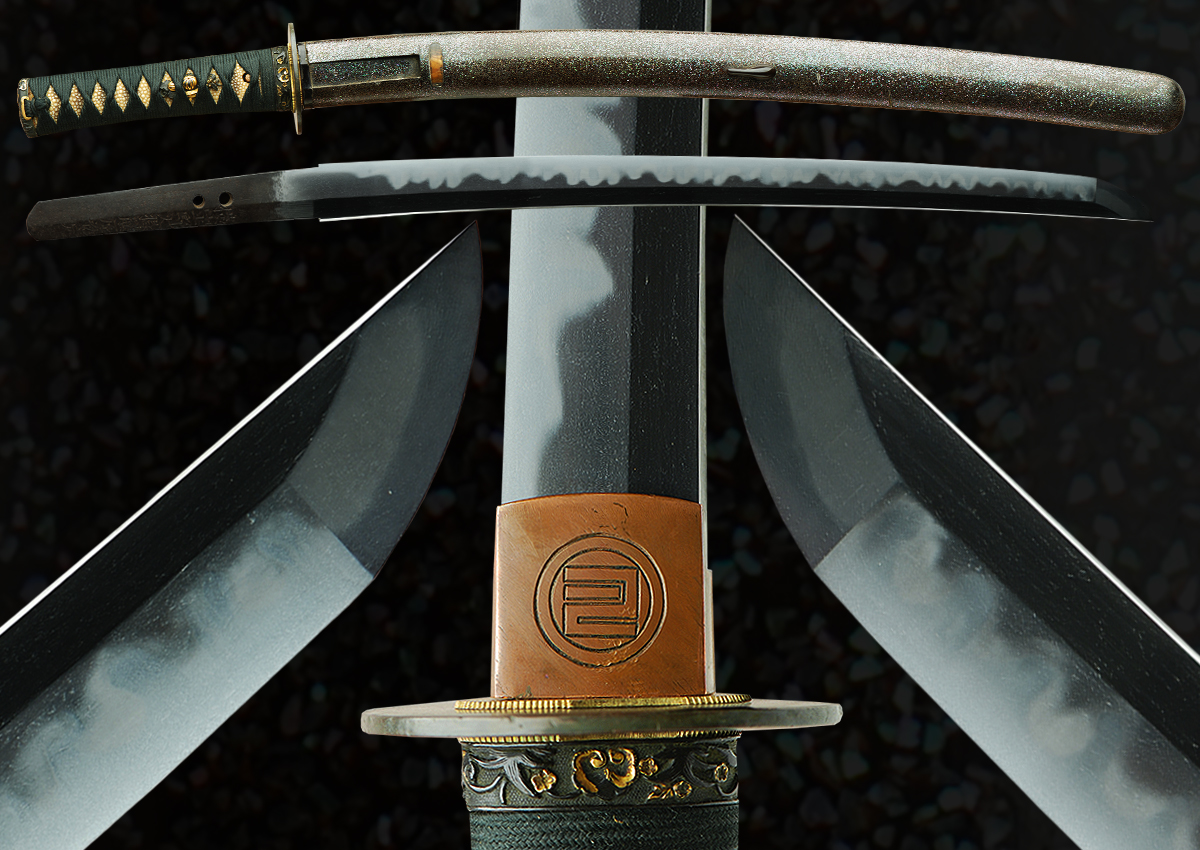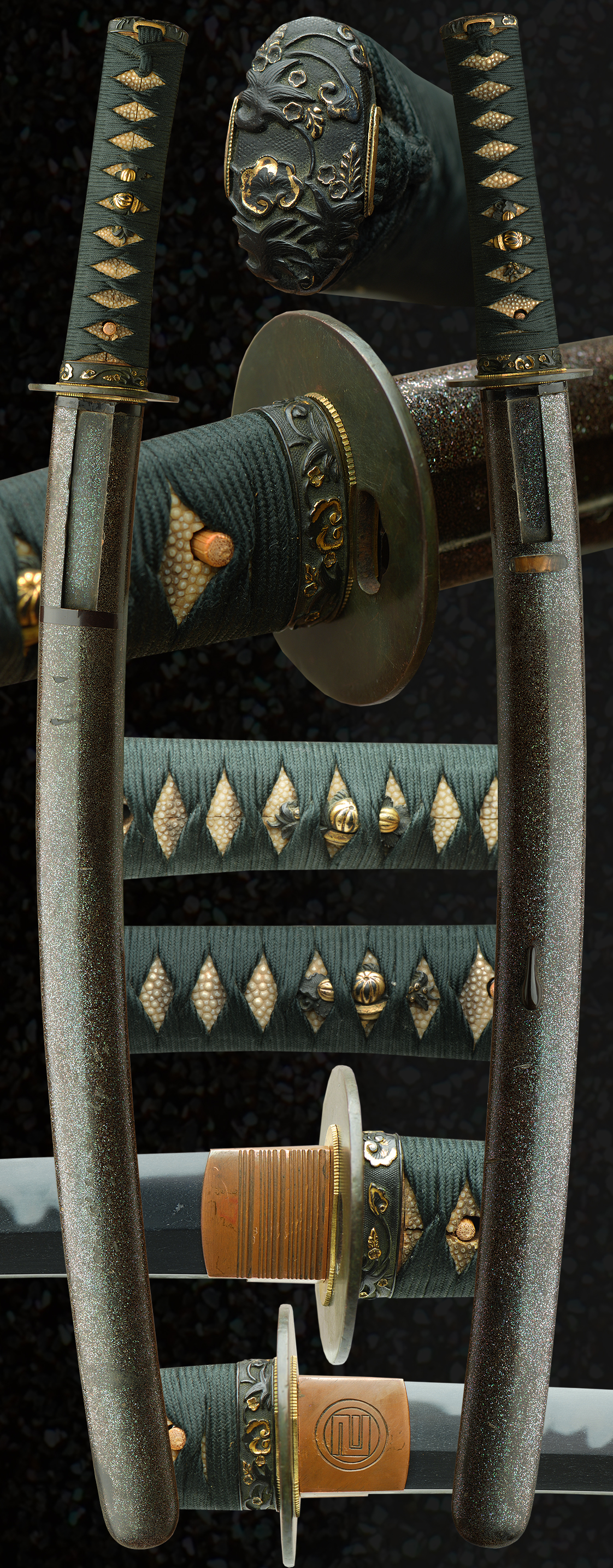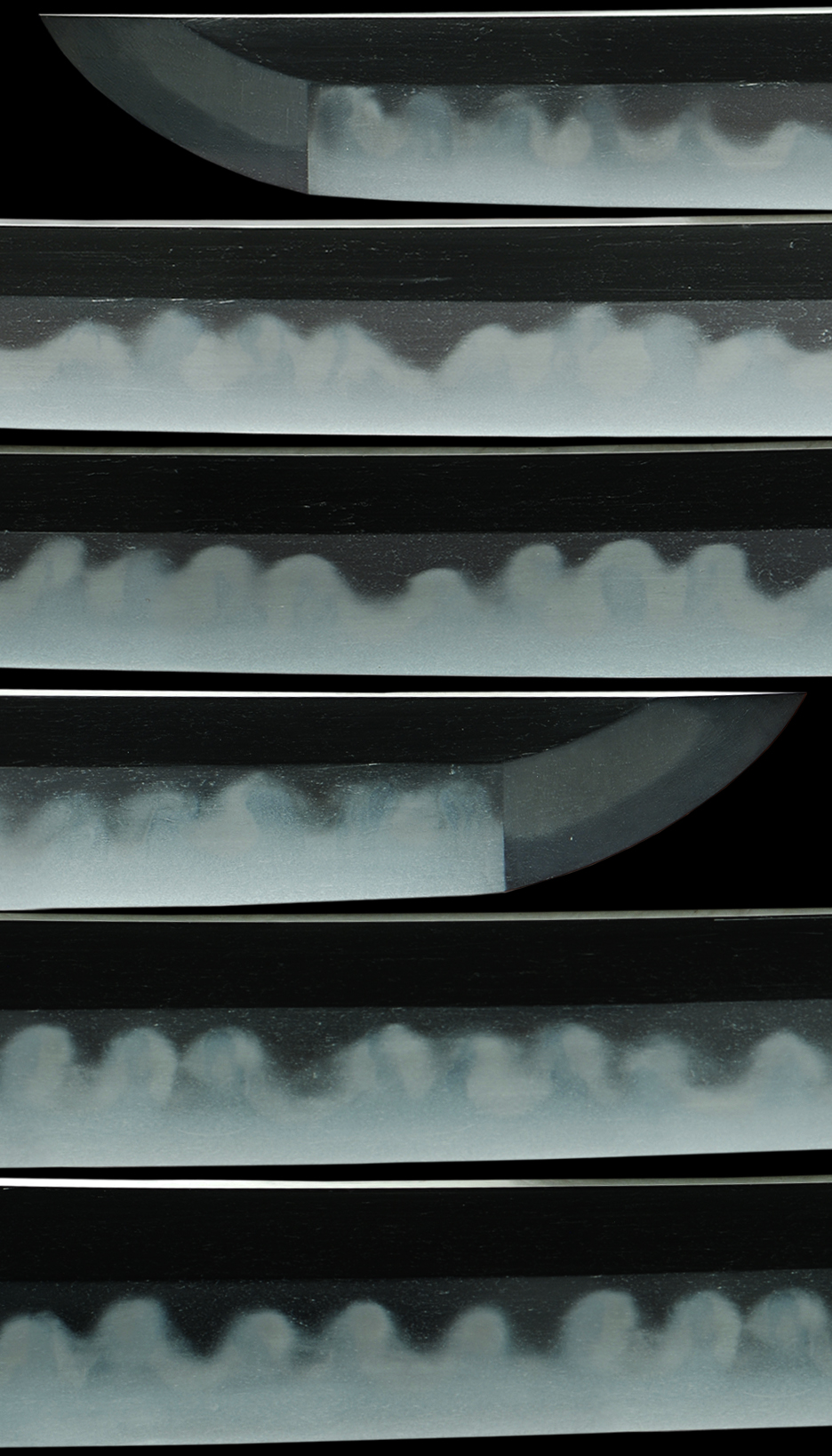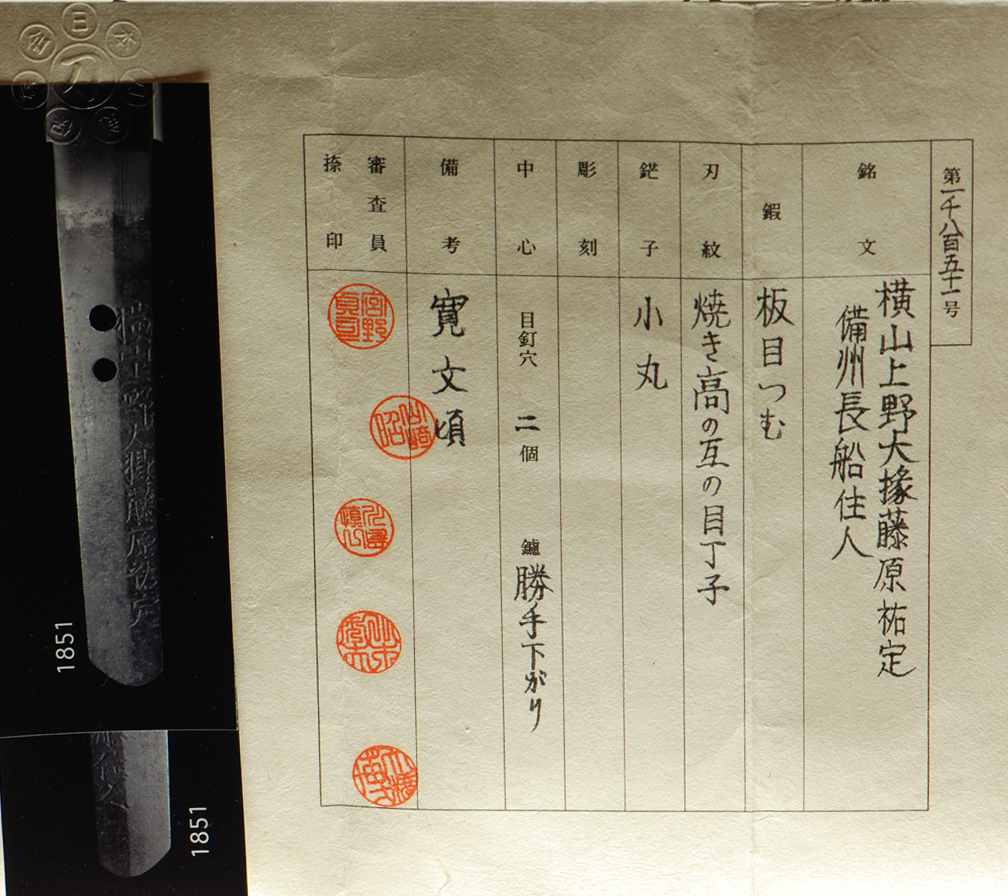A beautiful flawless blade in the tradition of Yokoyama Sukesada of the Shinto period. This blade is from the 1st generation of this smith from this era. This blade is by the Shinto Sukesada smith who singlehandedly saved this school from obliteration after the great flood of the Yoshii River in 1591 which wiped out almost the entire school. This smith is responsible for the founding of the Yokoyama branch which was especially made famous during the Shinshinto era.
The Bizen tradition of sword craft reigned supreme as the longest and most successful line of smith in Japanese Sword history, spanning over 1200 years of sword manufacture, born with the smith Tomonari in the 10th century AD. From Tomonari, the successive centuries saw the development of other schools working in the Bizen tradition such as, Ichimonji, Ko-osafune, Kozori, Osafune, Yoshii, Omiya, and the extensive Sukesada school, from which the school of this sword, Yokoyama,emerged. The quality of works ebbed and flowed with the tides of warfare, with quality yielding to demands of quantity during the dark times of the great civil wars that tore the country apart at the seams. Two calamitous floods also scoured Osafune village twice within a relatively short period and one historic text says that the only smithing family to survive was the Yokoyama family. It’s no coincidence then that with the transition into the Shinto period a few short years later, that the Yokoyama Sukesada line of smiths occupies a place in sword manufacture, keeping breath of life in their tradition after the decimation of the lines after war and natural disaster. The roots of Bizen sword craft remain in the present day with artisans working in Okayama where the famous origin of “Osafune” town lies at the Bizen Okayama Sword Museum. The Bizen traditions are also a major source of inspiration to many other modern day Japanese swordsmiths.
Yokoyama Kozuke Daijo Sukesada is thought to be the sixth generation of that name descended from the famed Yosozaemon Sukesada of the late Muromachi period. He received his title of Kozuke Daijo in 1664. His father was Hichibei Sukesada. Of the smiths to carry the Sukesada name in the Shinto period, Kozuke Daijo Sukesada is the most outstanding to the point that when the name of Sukesada arises in the context of a Shinto work, this is the smith that is assumed to be referred. He died in 1689 at the age of 89.
This wakizashi is in pristine condition and testifies to the quality of workmanship for which he is regarded, and remains faithful to the Bizen traditions of old with a stout form and classic Bizen curvature. This blade clearly is skillfully forged with a jigane of tightly knit ko-mokume-itame hada, supporting a consistent and vibrant nioideki habuchi in midare with togari fingers reaching up into the ji throughout.
Fujishiro notes him as Jo-saku and has this to say:
SUKESADA KÔZUKE NO DAIJÔ [KANBUN 1661 BIZEN] SHINTÔ JÔSAKU
His common name is Heibei, and he is the grandson of Nagamasa Yosôzaemon in the sixth generation. He is the son of Hichibei Sukesada, and he received the title of Kôzuke no Daijô in Kanbun Yonen (1664). It is thought that both his works and his succession to the name (Sukesada) began from this time. He died at the age of 89 in the winter of Jôkyô Rokunen (1689).
Signatures: BISHÛ OSAFUNE JÛ YOKOYAMA KÔZUKE NO DAIJÔ FUJIWARA SUKESADA
YOKOYAMA KÔZUKE NO DAIJÔ FUJIWARA SUKESADA
BIZEN KUNI OSAFUNE JÛ SUKESADA
YOKOYAMA KÔZUKE NO KAMI FUJIWARA SUKESADA
Plate I: KANBUN ROKUNEN NIGATSU KICHIJITSU
Plate II: BISHÛ OSAFUNE JÛ YOKOYAMA KÔZUKE NO DAIJÔ FUJIWARA SUKESADA
Page 488
Plate I: BISHÛ OSAFUNE JÛNIN
Plate II: YOKOYAMA KÔZUKE NO DAIJÔ FUJIWARA SUKESADA
The prosperity of the Bizen tôkô in the shintô period was probably centered around this Yokoyama Kôzuke no Daijô !
The koshirae is a true Edo period piece. The Tsuka still sports the original Ito of blue. The fittings are elegantly matched of a vine and gourd motif finished with shakudo and gold. The samegawa has a beautiful patina and the tsuba is a very nice ( Maru-gata ) rounded style with plain background. There are 2 areas for kozuka and kogai or waribashi. The kurikata it seems was removed at one point and was filled or plugged. This is an original repair of which could be changed at the new owners request.
The habaki is one of the most unique I have seen. It is constructed of copper with an obscure family mon of the Genjiko-no-zu which was most likely the family who owned this blade originally. It is deeply carved and the other side has varied rows of horizontal lines of different thicknesses. There are gold washed seppa as well as shitadome.
TO NOTE ABOUT THE MON:
<Habaki>
Design: 家紋 Family Crest,源氏香図 Genjiko-no-zu
香道 Kōdō
Kōdō (香道, “Way of Fragrance”) is the art of appreciating Japanese incense,
and involves using incense within a structure of codified conduct. Kōdō includes
all aspects of the incense process, from the tools (香道具 kōdōgu), to activities
such the incense-comparing games kumikō (組香) and genjikō (源氏香).[1] Kōdō is
counted as one of the three classical Japanese arts of refinement, along with
kadō for flower arrangement, and chadō for tea and the tea ceremony.
聞香 Monkō,源氏香 Genjiko
“The art of enjoying incense, with all its preparatory aspects, is called monkō (聞香),
which translated means “listening to incense”. The aim is to let the aroma of the material
infuse the body and soul and “listen” to its essence in a holistic manner, as opposed to
just reducing it to smelling.[10] Monkō has been depicted in Japanese art, with a well-known
depiction by the artist Shinsui Itō (1898–1972).[11]
Participants sit near one another and take turns smelling incense from a censer as they pass
it around the group. Participants comment on and make observations about the incense, and play
games to guess the incense material. Genjikō is one such game, in which participants are to
determine which of five prepared censers contain different scents, and which contain the same
scent. Players’ determinations (and the actual answers) are recorded using genji-mon linear
patterns, the elements of which allude to chapters in the Tale of Genji.[12] The geometric
genji-mon patterns are also used for decoration in a number of other areas such as kimono,
Japanese lacquerware and Japanese pottery.”
There is also a Kaeshizuno (返し角) – a hook shaped fitting used to lock the saya to the obi while drawing.
The saya is a SPECTACULAR suspension of Abalone or seashell in lacquer and an original Edo period piece. An original Japanese polish papered with shirasaya also. Just open any Taikan or Meikan and he will be the quintessential example smith of the Bizen school from the Shinto era. All in all a great example for the connoisseur to add to their collection.
Please note that this sword comes with a shirasaya also but we did not take picture of it. Its in good shape and was made to protect the sword and its polish.
- Mei: BISHÛ OSAFUNE JÛNIN YOKOYAMA KÔZUKE NO DAIJÔ FUJIWARA SUKESADA
- Date: Edo (1600’s-1700’s)
- Nagasa: 16-1/8 inches
- Sori: 9.0 mm
- Width at the ha-machi: 29.0 mm
- Width at the yokote: 20.9mm
- Thickness at the mune-machi: 6.8 mm
- Construction: Shinogi zukuri
- Mune: Iori
- Nakago: Ubu
- Kitae: Itame/mokume
- Hamon: Midare Gunome
- Boshi: Maru
- Condition: Good polish
Asking price: $4,800.00
Email us if your interested in this item and remember to include the order number for this item: fss-760.
Click to Enlarge Image
For Sale

























